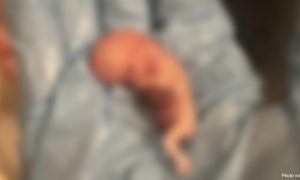There is much discussion to be had about InVitro Fertilization (IVF) and Artificial Reproductive Technology (ART) overall. However a child is brought into this world, he or she is worthy of life and the dignity all human beings deserve.
Because all human beings have worth and deserve that dignity, some would argue against IVF for how the process treats children as a commodity in the way in which it creates them. That issue and others associated with IVF have been discussed at length, but there is a specific focus worth considering here in going deeper into the procedure.
Earlier this month, a photo of a mother with her infant quintuplets went viral. In describing the family and the photo shoot, the photographer explained that the mother, Kim, was presented with the idea of “the selection method.” This process would target three of her babies for abortion in order to give a better chance of survival to the other two. Kim bravely refused, and all five, a boy and four girls, were born healthy.
Other parents have not been so lucky, and a father whose wife turned to the method has been haunted, noting that “my soul carries a new scar.”
Kim did not use fertility drugs, but she is still mentioned in this context because the chances of this pregnancy then were one in 55 million.
The process of “selective reduction” is usually offered in the context of those who conceive using ART, such as through IVF. The term is really just fancily dressing up abortion, and pitting preborn siblings against each other by targeting one or more for the survival of the other(s).
Woman are often injected with several human embryos in order to maximize her chances of giving birth. And then when she does, and the more than one embryo survives, the attitude seems to be glad it worked, but maybe it worked too well and some of the new lives must be terminated.
Fortunately that mentality does not occur in all circumstances. Vicki and Simon Moore conceived a daughter through IVF, even though their daughter had the chance of being born with Treacher Collins syndrome, a genetic disorder that affects facial structure and hearing, which Simon had. The couple had the option of genetic testing, but opted out since they knew if they went through with it, their child would be destroyed as an embryo. Their daughter, Alice, does have TC, but she is still loved by her family.
As touching as that story is, it shouldn’t be the exception for those who undergo ART to have children. This overall mentality is also reflected through last month’s scientific report which finds that when life begins at conception, the chemical processes can be captured with a flash of florescent light.
As exciting as this is, it may not be as life-affirming as it initially seems. Scientists also note that the healthier the egg, the brighter the light, which they then associate with being able to determine which are “the good ones” when it comes to IVF. Seriously, scientists refer to the new creation of life in such a way.
If IVF is to exist in our society as a way to conceive children, then it needs to be done in a way that is consistent with trying to actually have children. Most importantly, to do so would be in a way that creates and protects rather than destroys life.







